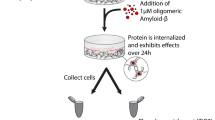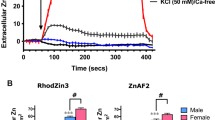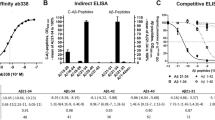Abstract
Alzheimer's disease (AD) is characterized by β-amyloid plaques, tau pathology, cholinergic cell death and inflammation. The aim of this study was to investigate whether β-amyloid is generated, released and extracellularly deposited in organotypic brain slices. In developing slices, no amyloid-precursor protein (APP) was detectable; however, there was a strong upregulation in aging slices. In such slices, rat β-amyloid(1–42) and -(1–40) peptides were found using four sequence-specific antibodies. APP and β-amyloid were expressed in neurons and to a lesser extent in astrocytes. Beta-amyloid was secreted into the medium. Beta-amyloid was located extracellularly when aging slices were incubated with medium at pH 6.0 including apolipoprotein E4 (ApoE4). It is concluded that aging organotypic brain slices express β-amyloid and that acidosis induces cell death with efflux of β-amyloid and extracellular depositions, which is triggered by ApoE4. This novel in vitro model may enable us to investigate further the pathological cascade for AD and may be useful to explore future therapeutics.
This is a preview of subscription content, access via your institution
Access options
Subscribe to this journal
Receive 12 print issues and online access
$259.00 per year
only $21.58 per issue
Buy this article
- Purchase on Springer Link
- Instant access to full article PDF
Prices may be subject to local taxes which are calculated during checkout








Similar content being viewed by others
References
Selkoe DJ . The cell biology of beta-amyloid precursor protein and presenilin in Alzheimer's disease. Trends Cell Biol 1998; 8: 447–453.
Mattson MP, Barger SW, Cheng B, Lieberburg I, Smith-Swintosky VL, Rydel RE . Beta-amyloid precursor protein metabolites and loss of neuronal Ca2+ homeostasis in Alzheimer's disease. Trends Neurosci 1993; 16: 409–414.
Checler F . Processing of the beta-amyloid precursor protein and its regulation in Alzheimer's disease. J Neurochem 1995; 65: 1431–1444.
Masliah E . Role of amyloid precursor protein in the mechanisms of neurodegeneration in Alzheimer's disease. Lab Invest 1997; 77: 197–209.
Gandy S, Greengard P . Processing of Alzheimer A-beta-amyloid precursor protein: cell biology, regulation, and role in Alzheimer disease. Int Rev Neurobiol 1994; 36: 29–50.
Yankner BA . Mechanisms of neuronal degeneration in Alzheimer's disease. Neuron 1996; 16: 921–932.
Atwood CS, Obrenovich ME, Liu T, Chan H, Perry G, Smith MA et al. Amyloid-beta: a chameleon walking in two worlds: a review of the trophic and toxic properties of amyloid-beta. Brain Res Rev 2003; 43: 1–16.
Davies P, Maloney AJF . Selective loss of central cholinergic neurons in Alzheimer's disease. Lancet 1976; 2: 1403.
Whitehouse PJ, Price DL, Struble RG, Clark AW, Coyle JT, Delon MR . Alzheimer's disease and senile dementia: loss of neurons in basal forebrain. Science 1982; 215: 1237–1239.
Winkler J, Thal LJ, Gage FH, Fisher LJ . Cholinergic strategies for Alzheimer's disease. J Mol Med 1998; 76: 555–567.
Selkoe DJ . Alzheimer's disease is a synaptic failure. Science 2002; 298: 789–791.
Terry AV, Buccafusco JJ . The cholinergic hypothesis of age and Alzheimer's disease-related cognitive deficits: recent challenges and their implications for novel drug development. J Pharmacol Exp Ther 2002; 306: 821–827.
Masliah E . Mechanisms of synaptic pathology in Alzheimer's disease. J Neural Transm 1998; 53: 147–158.
Hardy J, Selkoe D . The amyloid hypothesis of Alzheimer's disease: progress and problems on the road to therapeutics. Science 2002; 298: 353–356.
Humpel C, Weis C . Nerve growth factor and cholinergic CNS neurons studied in organotypic brain slices: Implications in Alzheimer's disease. J Neural Transm 2002; 62: 253–263.
Weis C, Marksteiner J, Humpel C . Nerve growth factor and glial cell line-derived neurotrophic factor restore the cholinergic phenotype in organotypic brain slices of the basal nucleus of Meynert. Neuroscience 2001; 102: 129–138.
Lechner T, Adlassnig C, Humpel C, Kaufmann WA, Maier H, Reinstadler-Kramer K et al. Chromogranin peptides in Alzheimer's disease. Exp Gerontol 2004; 39: 101–113.
Humpel C, Wetmore C, Olson L . Regulation of brain-derived neurotrophic factor messenger RNA and protein at the cellular level in pentylenetetrazol-induced epileptic seizures. Neuroscience 1993; 53: 909–918.
Brice A, Berrard S, Raynaud B, Ansieau S, Coppola T, Weber MJ et al. Complete sequence of a cDNA encoding an active rat choline acetyltransferase: a tool to investigate the plasticity of cholinergic phenotype expression. J Neurosci Res 1989; 23: 266–273.
Forloni G, Del Bo R, Angeretti N, Smiroldo S, Gabellini N, Vantini G . Nerve growth factor does not influence the expression of beta-amyloid precursor protein mRNA in rat brain: in vivo and in vitro studies. Brain Res 1993; 620: 292–296.
Gähwiler BH, Capogna M, Debanne D, McKinney RA, Thompson SM . Organotypic slice cultures: a technique has come of age. Trend Neurosci 1997; 20: 471–477.
Stoppini L, Buch PA, Muller D . A simple method for organotypic cultures of nervous tissue. J Neurosci Meth 1991; 37: 173–182.
Masliah E, Rockenstein E . Genetically altered transgenic models of Alzheimer's disease. J Neural Transm 2000; 59: 175–183.
Duff K, Noble W, Gaynor K, Matsuoka Y . Organotypic slice cultures from transgenic mice as disease model systems. J Mol Neurosci 2002; 19: 317–320.
Kang J, Muller-Hill B . Differential splicing of Alzheimer's disease amyloid A4 precursor RNA in rat tissues: PreA4(695) mRNA is predominantly produced in rat and human brain. Biochem Biophys Res Comm 1990; 166: 1192–1200.
Rohan de Silva HA, Jen A, Wickenden C, Jen LS, Wilkinson SL, Patel AJ . Cell specific expression of beta-amyloid precursor protein isoform mRNAs and proteins in neurons and astrocytes. Mol Brain Res 1997; 47: 147–156.
Moreno-Flores MT, Salinero O, Wandosell F . Beta-amyloid(25–35)-induced APP expression in cultured astrocytes. J Neurosci Res 1998; 52: 661–671.
Mattson MP . Cellular actions of beta-amyloid precursor protein and its soluble and fibrillogenic derivatives. Physiol Rev 1997; 77: 1081–1132.
Tanzi RE, Bertram L . Twenty years of the Alzheimer's disease amyloid hypothesis: a genetic perspective. Cell 2005; 120: 545–555.
Golde TE . The Abeta hypothesis: leading us to rationally-designed therapeutic strategies for the treatment or prevention of Alzheimer disease. Brain Pathol 2005; 15: 84–87.
Busciglio J, Gabuzda DH, Matsudaira P, Yankner BA . Generation of beta-amyloid in the secretory pathway in neuronal and nonneuronal cells. Proc Natl Acad Sci USA 1993; 90: 2092–2096.
Iadecola C . Neurovascular regulation in the normal brain and in Alzheimer's disease. Nat Rev Neurosci 2004; 5: 347–360.
Humpel C, Marksteiner J . Cerebrovascular damage as a cause for Alzheimer's disease? Curr Neurovasc Res 2005; 2: 341–347.
Siesjo BK . Acidosis and ischemic brain damage. Neurochem Pathol 1988; 9: 31–88.
Siesjo BK . Pathophysiology and treatment of focal cerebral ischemia. Part I: Pathophysiology. J Neurosurg 1992; 77: 169–184.
Pirchl M, Marksteiner J, Humpel C . Effects of acidosis on brain capillary endothelial cells and cholinergic neurons: relevance for vascular dementia and Alzheimer's disease. NeurolRes 2006; 28: 657–664.
Wirths O, Multhaup G, Bayer TA . A modified beta-amyloid hypothesis: intrneuronal accumulation of beta-amyloid peptide—the first step of a fatal cascade. J Neurochem 2004; 91: 513–520.
Oddo S, Caccamo A, Smith IF, Green KN, LaFerla FM . A dynamic relationship between intracellular and extracellular pools of beta-amyloid. Am J Pathol 2006; 168: 184–194.
Marchesi VT . An alternative interpretation of the amyloid Abeta hypothesis with regard to the pathogenesis of Alzheimer's disease. Proc Natl Acad Sci USA 2005; 102: 9093–9098.
Schroeder BE, Koo EH . To think or not to think: synaptic activity and Abeta release. Neuron 2005; 48: 873–879.
Morato E, Mayor FJ . Production of the Alzheimer's beta-amyloid peptide by C6 glioma cells. FEBS 1993; 336: 275–278.
Chung H, Brazil MI, Soe TT, Maxfield FR . Uptake, degradation, and release of fibrillar and solube forms of Alzheimer's amyloid beta-peptide by microglial cells. J Biol Chem 1999; 274: 32301–32308.
Johnstone EM, Chaney MO, Norris FH, Pascual R, Little SP . Conservation of the sequence of the Alzheimer's disease amyloid peptide in dog, polar bear and five other mammals by cross-species polymerase chain reaction analysis. Mol Brain Res 1991; 10: 299–305.
Carrotta R, Manno M, Bulone D, Martorana V, San Biagio PL . Protofibril formation of amyloid beta-protein at low pH via a non-cooperative elongation mechanism. J Biol Chem 2005; 280: 30001–30008.
Atwood CS, Moir RD, Huang X, Scarpa RC, Bacarra ME, Romano DM et al. Dramatic aggregation of Alzheimer Abeta by Cu(II) is induced by conditions representing physiological acidosis. J Biol Chem 1998; 273: 12817–12826.
Matsunaga Y, Fujii A, Awasthi A, Yokotani J, Takakura T, Yamada T . Eight residue amyloid beta peptides inhibit the aggregation and enzymatic activity of amyloid-beta42. Regul Peptides 1994; 120: 227–236.
Yip AG, McKee AC, Green RC, Wells J, Young H, Cupples LA et al. APOE, vascular pathology, and the AD brain. Neurology 2005; 65: 259–265.
Holtzman DM, Fagan AM, Mackey B, Tenkova T, Sartorius L, Paul SM et al. Hyman BT. Apolipoprotein E facilitates neuritic and cerebrovascular plaque formation in an Alzheimer's disease model. Ann Neurol 2000; 47: 739–747.
Katzman R . Apolipoprotein E and Alzheimer's disease. Curr Opin Neurobiol 1994; 4: 703–707.
Strittmatter WJ, Roses AD . Apolipoprotein E and Alzheimer disease. Proc Natl Acad Sci USA 1995; 92: 4725–4727.
Bales KR, Verina T, Cummins DJ, Du Y, Dodel RC, Saura J et al. Apolipoprotein E is essential for amyloid deposition in the APP(V717F) transgenic mouse model of Alzheimer's disease. Proc Natl Acad Sci USA 1999; 96: 15233–15238.
Acknowledgements
This study was supported by the Austrian Science Fund (P16130-B08 and P19122-B05). We thank Iris Berger, Michael Pirchl and Ursula Kirzenberger-Winkler for excellent technical help. We also thank Dr Georg Wietzorrek for help with the confocal microscopy.
Author information
Authors and Affiliations
Corresponding author
Additional information
Competing interests statement
The authors declare that they have no competing financial interests.
Rights and permissions
About this article
Cite this article
Marksteiner, J., Humpel, C. Beta-amyloid expression, release and extracellular deposition in aged rat brain slices. Mol Psychiatry 13, 939–952 (2008). https://doi.org/10.1038/sj.mp.4002072
Received:
Revised:
Accepted:
Published:
Issue Date:
DOI: https://doi.org/10.1038/sj.mp.4002072
Keywords
This article is cited by
-
Organotypic whole hemisphere brain slice models to study the effects of donor age and oxygen-glucose-deprivation on the extracellular properties of cortical and striatal tissue
Journal of Biological Engineering (2022)
-
Organotypic brain slice cultures to model neurodegenerative proteinopathies
Molecular Neurodegeneration (2019)
-
Iron transport across the blood–brain barrier: development, neurovascular regulation and cerebral amyloid angiopathy
Cellular and Molecular Life Sciences (2015)
-
Role of pH in structural changes for Pin1 protein: an insight from molecular dynamics study
Journal of Molecular Modeling (2014)
-
Amyloid beta dimers/trimers potently induce cofilin-actin rods that are inhibited by maintaining cofilin-phosphorylation
Molecular Neurodegeneration (2011)



